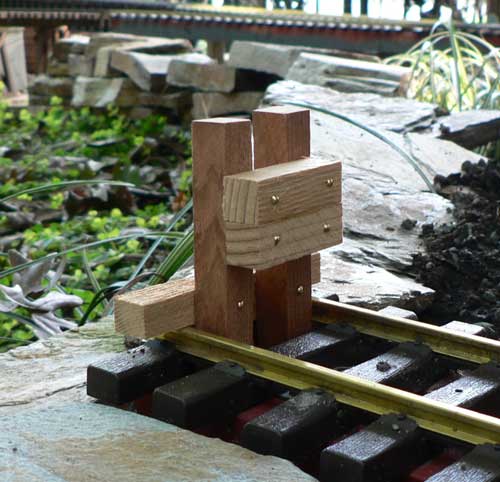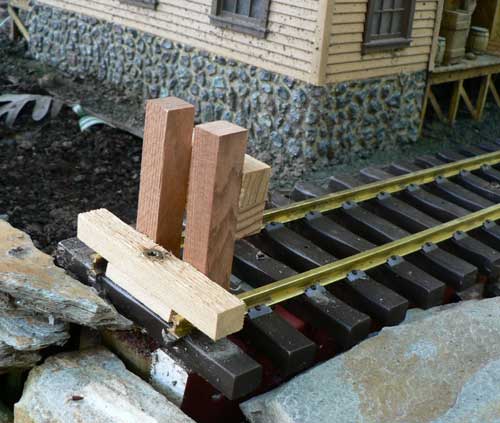Now that I’m getting further along with my layout, I’m looking for a good bumper design. Something fairly easy to do as I’ve got a lot of tracks to terminate.
Any ideas?
Now that I’m getting further along with my layout, I’m looking for a good bumper design. Something fairly easy to do as I’ve got a lot of tracks to terminate.
Any ideas?
I use and like the Aristocraft one. It’s lighted and that tells me if my siding is live or dead. Nothing more frustrating than backing a train into a siding only to see the locomotive jerk to a stop because I forgot to throw the power switch to that siding. But, since you are battery power, it would do you no good. I would say that visually I like the “bent rail” type as a favorite.
Warren
Bruce,
The prototype generally used the cheapest and most expedient way to provide protection at the end of sidings. Traditional bumpers such as lighted ones and even the bent rail types were used mostly at passenger terminals or more critical locations such as a track ending at a busy street, etc. Most sidings (industrial and in freight yards) were simply ties bolted on top of the rails or even stacks of ties. The SP’s “Desert Yard” in Oakland merely dumped a pile of earth and ballast at the ends of most of the tracks. Often times there was a car’s truck imbedded in the dirt pile where a string of cars had been shoved too hard.
I’m using a combination of ties and wooden bumpers on my sidings. At the cattle pens I’ve stacked 3 wooden ties in a pyramid fashion and driven brads through the bumper ties and into the track ties beneath rather than model the bolt/bracket method most commonly used. The prototype often used a single tie with brackets, one over the top of the tie and another beneath the rail with a long bolt on each side of the rail on both sides of the track to clamp it tight. A bumper wasn’t intended to stop a charging train. It was meant to merely stop a car that was nudged a bit too hard or to prevent a car from rolling off the end of the track. As already stated a simple pile of earth at the end of sidings will also suffice.
The railroads never were ones for spending money needlessly so more formal bumpers were reserved for high risk city or passenger areas.
I like the way you think Richard. Cheap and easy.
Bruce Chandler said:Bruce,
I like the way you think Richard. Cheap and easy.
Looking at things they use on the short lines here in the Valley, that is pretty prototypical.
No money for fancy extras!
Bruce Chandler said:Hehe! I've always been noted for being cheap and easy! ;)
I like the way you think Richard. Cheap and easy.
The VRR has two “Bumper Blocks” that I know of … one at the Deep River station at the end of the house track, and one in Essex at the end of the dump pit on the EE Dickenson Witch Hazel plant… which hasn’t had a track to it in years, but it’s part of the plant building’s ironwork (they quit making Witch Hazel there years ago and converted the factory to office space…) THese bumper blocks are the “Bent Rail” type with the central metal block at coupler height, and are braced by more bent rail (or in the case of the pit one, heavy steel) from the rear.
More common is the track that just dead ends into the mud … though, often if it’s something that’s going to be used there’s a tie stuck under one rail and over the opposite one between two of the last ties, kind of a permanent chock. I’ve seen that approach elsewhere, with a pair of ties like this in opposite directions… no bolting required; the weight of the track holds everything in place.
Some tracks have the bolted on “Wheel Stops” similar to the one Hilliman’s Railclamps makes, where there’s an iron crescent that slides onto the railhead and bolts in place … used singly or in pairs… (though the Hilliman’s ones would require some grind and paint to look at all prototypical)
Conrail seemed to use the “Pile O Ballast” approach on a lot of their intermediate sidings on the Berkshire division when I worked there. The Norfolk Southern has a siding in High Point that uses one of those orange and white construction barrels, which replaces the highway orange cone that marked the end of “useable” track near the station platform … not exactly a bumper block, but designed along the same thought. I believe they have one of those “slanted ties” as described above a bit further up … just in case.
The most prodigious bumper block I’ve ever seen was the one at the end of the pier on the White Pass and Yukon… a massive concrete filled steel post with a block at coupler height is imbedded in the pier between the rails … looks like it’d stop the train at speed!
Of course, you know you’re not supposed to actually hit one of these things, right? Things stop … in a hurry.
Matthew (OV)
I’ve used the Artisto lighted bumper and haven’t been impressed. They look OK, perhaps a bit too heavy, but they don’t hold if you ram them. They also break quite easily if you are not very careful installing them. Not something I would use indoors at the end of the benchwork. Currently indoors at the edge of the benchwork I put a 1x2 railing up around the stub yard end to keep wayward cars off the floor.
Outdoors at the end of the mainline wye I use a brick buried 1/2 way in the dirt. Even if you hit it full throttle, the loco will stop, but sometimes not all the detail pieces do :o On the industrial sidings, when I get them built, I’ll probably use the Aristo 'cause I have a bunch.
Nothing wrong with the simple stacked ties / earth mound etc. Here at the ex New Haven Danbury Yard most tracks have nothing at the end. They few that do just have the bolt-on wheel stops. I guess they never had any problems putting cars on the ground.
JR
The Arghristo one works good if you remove the light and run a LONG drywall screw down the hole with a washer.
I use Ozark wheelstops.
They mount with 5-minute clear epoxy.
There are…oh…one or two AC units somewhere on the road, about 3 big LGB woodpile bumpers (maybe 4), and the rest are Ozark, except for 3 or 4 fabricated wood stops.
I have a LOT of spurs…
Well, inspired by Yogi and some prototypes, I came up with my own design. I wanted something that wouldn’t take up very much room and would stop a car if necessary. It’s simple and cheap. I made it from pieces of wood in my scrapbox and some brass escutcheon pins (along with some glue) to hold things together.


A screw holds it in place. I ended up making a little jig to speed assembly, so I can build one of these in just a few minutes.
Add a little stain and you should be good to go. 
Warren
Richard Smith said:I'm easy, but I ain't cheap!Bruce Chandler said:Hehe! I've always been noted for being cheap and easy! ;)
I like the way you think Richard. Cheap and easy.
Hi, keep it simple, do it like the prototype:

Use some old ties. Have Fun Juergen Zirner
Zirner said:Of course, in this case the moving object will stop short when it hits the sky.
Hi, keep it simple, do it like the prototype: Juergen Zirner
Hi, OK, I substituted the sky with some rock (models) from my stupidium oxyde mine. But the upright sleepers are still there.

Its part of a larger32mm gauge track exibition layout (150 feet) , 1 : 22,5 sale, livesteam and battery-remotecontrol. Trackpower was yesterday. Have Fun Juergen Zirner
Zirner said:
Hi,OK, I substituted the sky with some rock (models) from my stupidium oxyde mine. But the upright sleepers are still there.
Its part of a larger32mm gauge track exibition layout (150 feet) , 1:22,5 sale, livesteam and battery-remotecontrol. Trackpower was yesterday.
By the way, the sky remark was a gentle jest, not a criticism.
Speaking as one who has used “sky” as the ultimate safety device on occasion.
Chris Vernell said:
By the way, the sky remark was a gentle jest, not a criticism.
Well, Chris, that was the way I understood it. I never mind good old humor and fun, when playing or discussing trains. Sometimes we position a friend or a visitor at the end of the line to work as a bumber:

In this case, it is the German Laser-King, Harald Brosch, responsible for many, many laserkits. Have Fun Juergen Zirner
Curmudgeon said:
I use Ozark wheelstops. They mount with 5-minute clear epoxy. I have a LOT of spurs…
Hi Curmudgeon, Could you please show a picture of the Ozark wheelstops on the rails of your layout? I have never seen any of your modelling anywhere. I tried the LGB plastic wheelstops, which simply clip to the rails, but since most of my American models have outside hung brake beams, this does not work too well.

Peco Code 250 Nickel Rail, LGB wheel stops, AMS 1 : 20,3 Flatcar. Have Fun Juergen Zirner
I think I like Juergen’s idea best.
Tom ,
D’ya mean the fat controller? I’d volunteer for that , I’m fat enough . Nice soft old buffer .
Mike